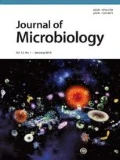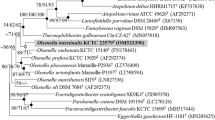Abstract
A strictly anaerobic, Gram-stain-positive, catalase-negative, non-motile, rod-shaped bacterium, designated SG0102T, was isolated from the small intestine of a swine. Optimal growth occurred at 37°C and pH 7.0. Furthermore, growth was observed in the presence of up to 3% (w/v) NaCl but not at salinity levels higher than 4%. The comparative analysis of 16S rRNA gene sequences showed that strain SG0102T was most closely related to Kandleria vitulina DSM 20405T (93.3%), followed by Catenibacterium mitsuokai KCTC 5053T (91.1%), Sharpea azabuensis KCTC 15217T (91.0%), and Eggerthia catenaformis DSM 5348T (89.6%). The average nucleotide identity values between strain SG0102T and related species, K. vitulina DSM 20405T, C. mitsuokai KCTC 5053T, S. azabuensis KCTC 15217T, and E. catenaformis DSM 5348T, were 71.0, 69.3, 70.0, and 69.2%, respectively. The phylogenetic analysis based on 16S rRNA gene sequence revealed that strain SG0102T belonged to the family Erysipelotrichaceae in the class Erysipelotrichia. The DNA G + C content of the strain SG0102T was 39.5 mol%. The major cellular fatty acids (> 10%) of strain SG0102T were C16:0, C16:0 dimethyl acetal, and C18:2ω9/12c. The cell wall peptidoglycan of strain SG0102T contained the meso-diaminopimelic acid. The strain SG0102T produced lactic acid as a major end product of fermentation. These distinct phenotypic and phylogenetic properties suggest that strain SG0102T represents a novel species in a novel genus of the family Erysipelotrichaceae, for which the name Intestinibaculum porci gen. nov. sp. nov. is proposed. The type strain is SG0102T (= KCTC 15725T = NBRC 113396T).
Similar content being viewed by others
References
Akasaka, H., Ueki, A., Hanada, S., Kamagata, Y., and Ueki, K. 2003. Propionicimonas paludicola gen. nov., sp. nov., a novel facultatively anaerobic, Gram-positive, propionate-producing bacterium isolated from plant residue in irrigated rice-field soil. Int. J. Syst. Evol. Microbiol. 53, 1991–1998.
Backhed, F., Ley, R.E., Sonnenburg, J.L., Peterson, D.A., and Gordon, J.I. 2005. Host-bacterial mutualism in the human intestine. Science 307, 1915–1920.
Bernardet, J.F., Nakagawa, Y., and Holmes, B. 2002. Subcommittee on the taxonomy of Flavobacterium and cytophaga-like bacteria of the international committee on systematics of prokaryotes proposed minimal standards for describing new taxa of the family Flavobacteriaceae and emended description of the family. Int. J. Syst. Evol. Microbiol. 52, 1049–1070.
Brestoff, J.R. and Artis, D. 2013. Commensal bacteria at the interface of host metabolism and the immune system. Nat. Immunol. 14, 676–684.
Chun, J. and Goodfellow, M. 1995. A phylogenetic analysis of the genus Nocardia with 16S rRNA gene sequences. Int. J. Syst. Bacteriol. 45, 240–245.
Colston, S.M., Fullmer, M., Beka, L., Lamy, B., Gogarten, J.P., and Graf, J. 2014. Bioinformatic genome comparisons for taxonomic and phylogenetic assignments using Aeromonas as a test case. mBio 5, e02136-14.
Cox, L.M., Sohn, J., Tyrrell, K.L., Citron, D.M., Lawson, P.A., Patel, N.B., Iizumi, T., Perez-Perez, G.I., Goldstein, E.J.C., and Blaser, M.J. 2017. Description of two novel members of the family Erysipelotrichaceae: Ileibacterium valens gen. nov., sp. nov. and Dubosiella newyorkensis, gen. nov., sp. nov., from the murine intestine, and emendation to the description of Faecalibaculum rodentium. Int. J. Syst. Evol. Microbiol. 67, 1247–1254.
De Man, J.C., Rogosa, M., and Sharpe, M.E. 1960. A medium for the cultivation of Lactobacilli. J. Appl. Bacteriol. 23, 130–135.
Douglas, W.R. 1972. Of pigs and men and research. Space Life Sci. 3, 226–234.
Felsenstein, J. 1981. Evolutionary trees from DNA sequences: a maximum likelihood approach. J. Mol. Evol. 17, 368–376.
Fitch, W.M. 1971. Toward defining the course of evolution: minimum change for a specific tree topology. Syst. Zool. 20, 406–416.
Guilloteau, P., Zabielski, R., Hammon, H.M., and Metges, C.C. 2010. Nutritional programming of gastrointestinal tract development. Is the pig a good model for man? Nutr. Res. Rev. 23, 4–22.
Hall, T.A. 1999. BioEdit: a user-friendly biological sequence alignment editor and analysis program for Window 95/98/NT, pp. 95–98. In Nucleic acids symposium series. Vol. 41. Information Retrieval Ltd., c1979-c2000, London, UK.
Kaakoush, N.O. 2015. Insights into the role of Erysipelotrichaceae in the human host. Front. Cell. Infect. Microbiol. 20, 84.
Kageyama, A. and Benno, Y. 2000. Catenibacterium mitsuokai gen. nov., sp. nov., a Gram-positive anaerobic bacterium isolated from human faeces. Int. J. Syst. Evol. Microbiol. 50, 1595–1599.
Kang, C., Zhang, Q., Zhu, W., Cai, C., Sun, X., and Jin, M. 2017. Transcription analysis of the responses of porcine heart to Erysipelothrix rhusiopathiae. PLoS One 12, e0185548.
Kim, J.S., Lee, K.C., Suh, M.K., Han, K.I., Eom, M.K., Lee, J.H., Park, S.H., Kang, S.W., Park, J.E., Oh, B.S., et al. 2019. Mediterraneibacter butyricigenes sp. nov., a butyrate-producing bacterium isolated from human faeces. J. Microbiol. 57, 38–44.
Kim, M., Oh, H.S., Park, S.C., and Chun, J. 2014. Towards a taxonomic coherence between average nucleotide identity and 16S rRNA gene sequence similarity for species demarcation of prokaryotes. Int. J. Syst. Evol. Microbiol. 64, 346–351.
Kimura, M. 1980. A simple method for estimating evolutionary rates of base substitutions through comparative studies of nucleotide sequences. J. Mol. Evol. 16, 111–120.
Kriss, M., Hazleton, K.Z., Nusbacher, N.M., Martin, C.G., and Lozupone, C.A. 2018. Low diversity gut microbiota dysbiosis: drivers, functional implications and recovery. Curr. Opin. Microbiol. 44, 34–40.
Kumar, S., Stecher, G., and Tamura, K. 2016. MEGA7: molecular evolutionary genetics analysis version 7.0 for bigger datasets. Mol. Biol. Evol. 33, 1870–1874.
Lozupone, C.A., Stombaugh, J.I., Gordon, J.I., Jansson, J.K., and Knight, R. 2012. Diversity, stability and resilience of the human gut microbiota. Nature 489, 220–230.
Malmuthuge, N., Griebel, P.J., and Guan, L.L. 2015. The gut microbiome and its potential role in the development and function of newborn calf gastrointestinal tract. Front. Vet. Sci. 2, 36–45.
Miller, E. and Ullrey, D. 1987. The pig as a model for human nutrition. Annu. Rev. Nutr. 7, 361–382.
Morita, H., Shiratori, C., Murakami, M., Takami, H., Toh, H., Kato, Y., Nakajima, F., Takagi, M., Akita, H., Masaoka, T., et al. 2008. Sharpea azabuensis gen. nov., sp. nov., a Gram-positive, strictly anaerobic bacterium isolated from the faeces of thoroughbred horses. Int. J. Syst. Evol. Microbiol. 58, 2682–2686.
Nagao-Kitamoto, H., Kitamoto, S., Kuffa, P., and Kamada, N. 2016. Pathogenic role of the gut microbiota in gastrointestinal diseases. Intest. Res. 14, 127–138.
Quast, C., Pruesse, E., Yilmaz, P., Gerken, J., Schweer, T., Yarza, P., Peplies, J., and Glöckner, F.O. 2013. The SILVA ribosomal RNA gene database project: improved data processing and web-based tools. Nucleic Acids Res. 41, D590–D596.
Saitou, N. and Nei, M. 1987. The neighbor-joining method: a new method for reconstructing phylogenetic trees. Mol. Biol. Evol. 4, 406–425.
Salvetti, E., Felis, G.E., Dellaglio, F., Castioni, A., Torriani, S., and Lawson, P.A. 2011. Reclassification of Lactobacillus catenaformis (Eggerth 1935) Moore and Holdeman 1970 and Lactobacillus vitulinus Sharpe et al. 1973 as Eggerthia catenaformis gen. nov., comb. nov. and Kandleria vitulina gen. nov., comb. nov., respectively. Int. J. Syst. Evol. Microbiol. 61, 2520–2524.
Sasser, M. 1990. Identification of bacteria by gas chromatography of cellular fatty acids, MIDI Technical Note 101. MIDI Inc., Newark, DE, USA.
Sorokin, D.Y. 2005. Is there a limit for high-pH life? Int. J. Syst. Evol. Microbiol. 55, 1405–1406.
Tegtmeier, D., Riese, C., Geissinger, O., Radek, R., and Brune, A. 2016. Breznakia blatticola gen. nov. sp. nov. and Breznakia pachnodae sp. nov., two fermenting bacteria isolated from insect guts, and emended description of the family Erysipelotrichaceae. Syst. Appl. Microbiol. 39, 319–329.
Thompson, J.D., Higgins, D.G., and Gibson, T.J. 1994. CLUSTAL W: improving the sensitivity of progressive multiple sequence alignment through sequence weighting, position-specific gap penalties and weight matrix choice. Nucleic Acids Res. 22, 4673–4680.
Tittsler, R.P. and Sandholzer, L.A. 1936. The use of semi-solid agar for the detection of bacterial motility. J. Bacteriol. 31, 575–580.
Verbarg, S., Rheims, H., Emus, S., Frühling, A., Kroppenstedt, R.M., Stackebrandt, E., and Schumann, P. 2004. Erysipelothrix inopinata sp. nov., isolated in the course of sterile filtration of vegetable peptone broth, and description of Erysipelotrichaceae fam. nov. Int. J. Syst. Evol. Microbiol. 54, 221–225.
Wood, R.L. and Shuman, R.D. 1975. Swine erysipelas, pp. 565–620. In Dunne, H.W. and Ames, A.D. (eds.), Diseases of swine, 4th ed. State University Press. Ames, USA.
Xiao, L., Estellé, J., Kiilerich, P., Ramayo-Caldas, Y., Xia, Z., Feng, Q., Liang, S., Pedersen, A.Ø., Kjeldsen, N.J., Liu, C., et al. 2016. A reference gene catalogue of the pig gut microbiome. Nat. Microbiol. 19, 16161.
Yoon, S.H., Ha, S.M., Kwon, S., Lim, J., Kim, Y., Seo, H., and Chun, J. 2017. Introducing EzBioCloud: a taxonomically united database of 16S rRNA gene sequences and whole-genome assemblies. Int. J. Syst. Evol. Microbiol. 67, 1613–1617.
Zhang, Q., Widmer, G., and Tzipori, S. 2013. A pig model of the human gastrointestinal tract. Gut Microbes 4, 193–200.
Author information
Authors and Affiliations
Corresponding author
Additional information
Supplemental material for this article may be found at https://doi.org/www.springerlink.com/content/120956.
Electronic supplementary material
Rights and permissions
About this article
Cite this article
Kim, JS., Choe, H., Lee, YR. et al. Intestinibaculum porci gen. nov., sp. nov., a new member of the family Erysipelotrichaceae isolated from the small intestine of a swine. J Microbiol. 57, 381–387 (2019). https://doi.org/10.1007/s12275-019-8631-8
Received:
Revised:
Accepted:
Published:
Issue Date:
DOI: https://doi.org/10.1007/s12275-019-8631-8




